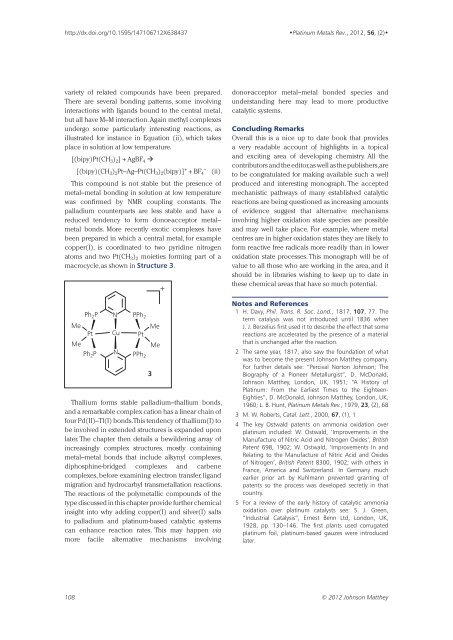Download article PDF - Platinum Metals Review
Download article PDF - Platinum Metals Review
Download article PDF - Platinum Metals Review
You also want an ePaper? Increase the reach of your titles
YUMPU automatically turns print PDFs into web optimized ePapers that Google loves.
http://dx.doi.org/10.1595/147106712X638437<br />
•<strong>Platinum</strong> <strong>Metals</strong> Rev., 2012, 56, (2)•<br />
variety of related compounds have been prepared.<br />
There are several bonding patterns, some involving<br />
interactions with ligands bound to the central metal,<br />
but all have M–M interaction. Again methyl complexes<br />
undergo some particularly interesting reactions, as<br />
illustrated for instance in Equation (ii), which takes<br />
place in solution at low temperature.<br />
[(bipy)Pt(CH 3 ) 2 ] + AgBF 4 <br />
[(bipy)(CH 3 ) 2 Pt–Ag–Pt(CH 3 ) 2 (bipy)] + –<br />
+ BF 4 (ii)<br />
This compound is not stable but the presence of<br />
metal–metal bonding in solution at low temperature<br />
was confirmed by NMR coupling constants. The<br />
palladium counterparts are less stable and have a<br />
reduced tendency to form donor-acceptor metal–<br />
metal bonds. More recently exotic complexes have<br />
been prepared in which a central metal, for example<br />
copper(I), is coordinated to two pyridine nitrogen<br />
atoms and two Pt(CH 3 ) 2 moieties forming part of a<br />
macrocycle, as shown in Structure 3.<br />
Me<br />
Ph 2 P<br />
Pt<br />
Me<br />
Ph 2 P<br />
N<br />
Cu<br />
N<br />
PPh 2<br />
Pt<br />
PPh 2<br />
Me<br />
Me<br />
Thallium forms stable palladium–thallium bonds,<br />
and a remarkable complex cation has a linear chain of<br />
four Pd(II)–Tl(I) bonds. This tendency of thallium(I) to<br />
be involved in extended structures is expanded upon<br />
later. The chapter then details a bewildering array of<br />
increasingly complex structures, mostly containing<br />
metal–metal bonds that include alkynyl complexes,<br />
diphosphine-bridged complexes and carbene<br />
complexes, before examining electron transfer, ligand<br />
migration and hydrocarbyl transmetallation reactions.<br />
The reactions of the polymetallic compounds of the<br />
type discussed in this chapter provide further chemical<br />
insight into why adding copper(I) and silver(I) salts<br />
to palladium and platinum-based catalytic systems<br />
can enhance reaction rates. This may happen via<br />
more facile alternative mechanisms involving<br />
3<br />
+<br />
donor-acceptor metal–metal bonded species and<br />
understanding here may lead to more productive<br />
catalytic systems.<br />
Concluding Remarks<br />
Overall this is a nice up to date book that provides<br />
a very readable account of highlights in a topical<br />
and exciting area of developing chemistry. All the<br />
contributors and the editor, as well as the publishers, are<br />
to be congratulated for making available such a well<br />
produced and interesting monograph. The accepted<br />
mechanistic pathways of many established catalytic<br />
reactions are being questioned as increasing amounts<br />
of evidence suggest that alternative mechanisms<br />
involving higher oxidation state species are possible<br />
and may well take place. For example, where metal<br />
centres are in higher oxidation states they are likely to<br />
form reactive free radicals more readily than in lower<br />
oxidation state processes. This monograph will be of<br />
value to all those who are working in the area, and it<br />
should be in libraries wishing to keep up to date in<br />
these chemical areas that have so much potential.<br />
Notes and References<br />
1 H. Davy, Phil. Trans. R. Soc. Lond., 1817, 107, 77. The<br />
term catalysis was not introduced until 1836 when<br />
J. J. Berzelius first used it to describe the effect that some<br />
reactions are accelerated by the presence of a material<br />
that is unchanged after the reaction.<br />
2 The same year, 1817, also saw the foundation of what<br />
was to become the present Johnson Matthey company.<br />
For further details see: “Percival Norton Johnson; The<br />
Biography of a Pioneer Metallurgist”, D. McDonald,<br />
Johnson Matthey, London, UK, 1951; “A History of<br />
<strong>Platinum</strong>: From the Earliest Times to the Eighteen-<br />
Eighties”, D. McDonald, Johnson Matthey, London, UK,<br />
1960; L. B. Hunt, <strong>Platinum</strong> <strong>Metals</strong> Rev., 1979, 23, (2), 68<br />
3 M. W. Roberts, Catal. Lett., 2000, 67, (1), 1<br />
4 The key Ostwald patents on ammonia oxidation over<br />
platinum included: W. Ostwald, ‘Improvements in the<br />
Manufacture of Nitric Acid and Nitrogen Oxides’, British<br />
Patent 698, 1902; W. Ostwald, ‘Improvements In and<br />
Relating to the Manufacture of Nitric Acid and Oxides<br />
of Nitrogen’, British Patent 8300, 1902; with others in<br />
France, America and Switzerland. In Germany much<br />
earlier prior art by Kuhlmann prevented granting of<br />
patents so the process was developed secretly in that<br />
country.<br />
5 For a review of the early history of catalytic ammonia<br />
oxidation over platinum catalysts see: S. J. Green,<br />
“Industrial Catalysis”, Ernest Benn Ltd, London, UK,<br />
1928, pp. 130–146. The first plants used corrugated<br />
platinum foil, platinum-based gauzes were introduced<br />
later.<br />
108 © 2012 Johnson Matthey
















